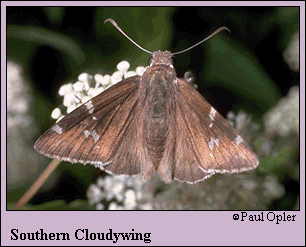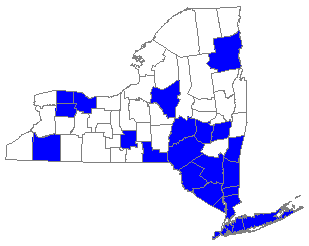 |
 

 |



Southern Cloudywing (Thorybes bathyllus [J. E. Smith])
Wing span: 1 5/16 - 1 7/8 inches (3.3 - 5 cm).
Identification: Hindwing is elongated. Upperside is dark brown; forewing has a wide band composed of aligned transparent spots. Male lacks a costal fold.
Life history: To seek females, males perch on vegetation 1.5 to 4.5 feet above ground, usually on hilltops or knolls. Some males appear to use the same perch throughout their lives (which lasts no more than 2 weeks). Females lay eggs singly on the underside of a host plant leaflet. Caterpillars feed on leaves and live in shelters of rolled or tied leaves. Fully-grown caterpillars hibernate.
Flight: One brood from mid-June to mid-July in the north; two broods (possibly three) from June-early October in most of its range.
Caterpillar hosts: Various plants in the pea family (Fabaceae) including beggar's ticks (Desmodium), bush clover (Lespedeza), clover (Trifolium), milkvetch (Astragalus), fuzzybean (Strophostyles), and wild bean (Glycine).
Adult food: Usually nectar from blue, purple, pink, or white flowers including dogbane, selfheal, crown vetch, Japanese honeysuckle, thistles, common milkweed, and others.
Habitat: Open, scrubby places including dry meadows, burned areas, dry prairie hills, powerline right-of-ways, and others.
Range: Most of the eastern United States from southern Maine west across the Great Lake States to Minnesota, Nebraska, southeastern Colorado, and northern New Mexico; south to central Florida, the Gulf Coast, and Texas.
Conservation: Not usually required.
The Nature Conservancy Global Rank: G5 - Demonstrably secure globally, though it may be quite rare in parts of its range, especially at the periphery.
Management needs: None reported.
References:
Opler, P. A. and G. O. Krizek. 1984. Butterflies east of the Great Plains. Johns
Hopkins University Press, Baltimore. 294 pages, 54 color plates.
Opler, P. A. and V. Malikul. 1992. A field guide to eastern butterflies. Peterson
field guide #4. Houghton-Mifflin Co., Boston. 396 pages, 48 color plates.
Scott, J. A. 1986. The butterflies of North America. Stanford University Press,
Stanford, Calif. 583 pages, 64 color plates.
Author: Jane M. Struttmann
State and Regional References:
Cech, R. 1993. A Distributional Checklist of the Butterflies and Skippers of
the New York City Area (50-mile Radius) and Long Island. New York City
Butterfly Club Special Publication. 27 pp.
Forbes, W.T.M. 1960. Lepidoptera of New York and Neighboring States. Part
IV: Agaristidae through Nymphalidae Including Butterflies. Cornell Univ.
Agricultural Experimental Station, Ithaca, N.Y. Memoir 371. 188 pp.
Glassberg, J. 1993. Butterflies Through Binoculars: A Field Guide to
Butterflies in the Boston-New York-Washington Region. Oxford Univ. Press,
New York, N.Y. 160 pp.
Klass, C. and Dirig, R. 1992. Learning about Butterflies. Cornell Cooperative
Extension Publication, 4-H Member/Leader Guide 139-M-9. Ithaca, N.Y.
36 pp.
Layberry, R.A., Hall, P.W. & Lafontaine, D.J., 1998. The Butterflies of
Canada. University of Toronto Press, Toronto, ON. 280 pp.
Opler, P.A. 1998. A field guide to eastern butterflies, revised format.
Houghton Mifflin Co., Boston.
Shapiro, A.M. 1974. Butterflies and Skippers of New York State. Cornell Univ.
Agricultural Experimental Station, Ithaca, N.Y. Search 4:1-60.

